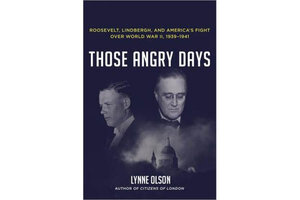Those Angry Days
Today we think of it as 'The Good War.' But Lynne Olson's excellent new book reminds us that, once upon a time, the question of US involvement in World War II was at least as contentious as Vietnam.

Those Angry Days: Roosevelt, Lindbergh, and America’s Fight Over World War II, 1939-1941 by Lynne Olson
Random House, 520 pp.
Lynne Olson is best known for “Citizens of London,” her 2010 bestseller about Americans who lived in London during the early days of World War II – and their valor and ingenuity in advancing a US role in England’s success against the Nazis. She is also the author of “Troublesome Young Men,” a 2007 chronicle of the upstart Tories who propelled Winston Churchill to the leadership of wartime Britain.
In Those Angry Days: Roosevelt, Lindbergh, and America’s Fight Over World War II, 1939-1941, as in her earlier projects, Olson focuses on a handful of key figures to plumb the broader historical currents sweeping events toward a dramatic milestone. “Those Angry Days” also invites comparison to Olson’s other work in revisiting one of her abiding preoccupations: the intersection between politics and war.
“Those Angry Days” takes its title from Arthur Schlesinger Jr., a New Deal Democrat and aide to John F. Kennedy who noted that the intensity of feeling regarding early US involvement in World War II has been largely forgotten. In the days before the Japanese attack on Pearl Harbor, when American interests in the widening global conflagration seemed less clear, the rift between isolationists and interventionists in the United States was wide and deep, said Schlesinger, who called the division “the most savage political debate of my lifetime.” He added this observation: “There have been a number of fierce national quarrels – over communism in the later Forties, over McCarthyism in the Fifties, over Vietnam in the Sixties – but none so tore apart families and friendships as this fight.”
As Olson notes in this absorbing chronicle, the bitterness of that debate has been obscured in postwar histories that focus on American unity and resolve after Dec. 7, 1941. In “Those Angry Days,” she assigns herself the task of recreating the splintered political climate of 1939-1941, when American policy toward the war was very much in a state of flux.
“Those Angry Days” promises to benefit from some good timing, coming as it does on the heels of “Lincoln,” the widely discussed Steven Spielberg film in which a compelling moral ideal – in this case, racial equality – operates against a backdrop of political expedience and sordid compromises. In Olson’s story, the evolution of America’s role in World War II, a conflict now remembered as "The Good War" fought by "The Greatest Generation," reveals equally imperfect political realities.
Some of the most unflattering episodes in “Those Angry Days” involve Charles Lindbergh, the celebrated American aviator who used his international stature to argue against early American participation in the war. The book’s period photos include a snapshot of Lindbergh and wife Anne visiting Nazi Luftwaffe chief Hermann Goering, one of numerous occasions in “Those Angry Days” when the reader winces at the thought of global terrors to come – and Lindbergh’s apparent blindness to the full implications of the Nazi regime. Even more unsettling is Olson’s detailed account of Lindbergh’s casual anti-Semitism, as when he blamed fledgling American pro-war sentiment at least partly on a Jewish media cabal.
But rather than demonizing Lindbergh, Olson parses the nuances of his early isolationism, noting that his reluctance to fight the Germans grew from several factors, including his conclusion that Nazi air power made diplomacy, rather than confrontation, the most practical way for Americans to address the European conflict before Pearl Harbor.
While not excusing Lindbergh’s racial views, Olson also notes that anti-Semitism was very much a part of his era, extending even to the White House, where Franklin Delano Roosevelt was known to make eye-rolling references to “Hebrew” culture. Roosevelt takes some other lumps in “Those Angry Days” for his lack of clarity concerning global questions when Europe began to unravel. As a president elected for his command of domestic policy during the Great Depression, FDR had to dramatically sharpen his foreign policy skills on the job, an evolution in which his inexperience often showed, Olson contends. In the early days of Nazi expansion into Czechoslovakia, with “the president making little or no attempt to persuade Americans that it was in the country’s best interests to help stop the dictators, the increasingly dire events in Europe only confirmed their determination to stay as far away from that hornet’s nest as possible,” she writes.
Olson, a former journalist, proves especially resourceful at combing through newspaper archives to flesh out her narrative with evocative detail. She doesn’t so much revisit a historical period as inhabit it; her scenes flicker as urgently as a newsreel. While highlighting Lindbergh and FDR as its stars, “Those Angry Days” embraces a cast of characters far beyond the book’s title characters. The story expands to include everyone from William Stephenson, an American-based operative for the British who partially inspired fictional spy James Bond, to young Theodor Geisel, whose cartoon spoof of Lindbergh’s isolationism helped hone the talents he’d bring to Dr Seuss.
About the end of this policy debate, we already know. The Japanese bombing of Hawaii brought America fully into World War II, fulfilling a famous Churchill quote that appears at the beginning of “Those Angry Days.”
“You can always count on Americans to do the right thing,” he declared, “after they’ve tried everything else.”
Danny Heitman, an author and a columnist for The Baton Rouge Advocate, is an adjunct professor at Louisiana State University’s Manship School of Mass Communication.

